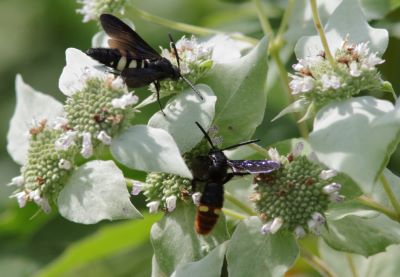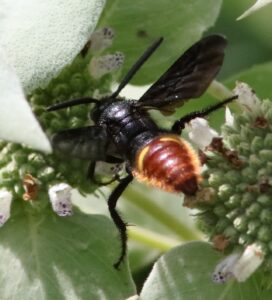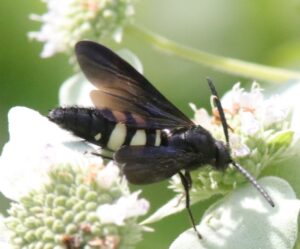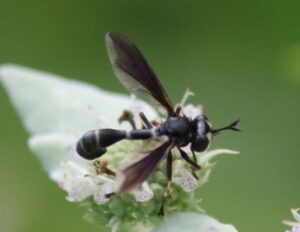
Two things happened recently. First, I finally decided to join the “Homegrown National Park” movement spearheaded by Doug Tallamy. The premise is every little effort can make a difference with natural systems. Since we bought our house in 1993, Eileen and I have tried our best to use predominantly native species of plants. Over the years, we have documented many visitors to the yard and plants. Considering our small yard (6000 sq. ft.) a homegrown National Park is (pardon the pun) a natural. Second, I decided that the various plants and animals in my yard can provide fodder for editions of my “Mercer’s Musings.’ After years of procrastination, I decide to make the leap. Recently I took my camera outside, I spend only about a half hour exploring our yard before a light drizzle pushed me inside to protect my camera.
After downloading the images, I realized that there were so many interesting things to delve into. What to pick? It could be the birds that visited–Ruby-throated Hummingbird, immature male Northern (Yellow-shafted) Flicker, or House Sparrow. Being a birder that seems too easy. Maybe the numerous insects. I decided to set aside the new species for my yard, the Red-banded Hairstreak, the evidence of a Goldenrod Gall midge, or the Sachems that swarmed over the New York Ironweed strictly because the list is too long.
The three species hanging about the Mountain Mint (Pycnanthemum muticum) fit the bill for interesting and manageable.

Blue Winged Wasp (Scolia dubia)
This docile distinctive species often found on our goldenrod, serves our yard by feeding on grubs like Japanese Beetles or June Bugs. This common wasp, found throughout most of the United States, can be recognized by its black (dark blue) wings, black head and thorax and rusty abdomen with two yellow eye spots. As an adult it feeds on nectar helping spread pollen from flower to flower.
This species breed in August, the primary focus of this insect at this time of the year. The male patrols for females who once mated search for her prey, beetle grubs especially Japanese Beetles. I have no clue how she finds them, but she will dig down into the ground, find a beetle grub, paralyzes the grub and lays a single egg, moves ono searching for more grubs. The egg hatches and the wasp larva consumes the living grub.
Years ago, I tried many ways to control Japanese Beetles with some success. Since we planted goldenrod and attracted the Double Banded Scoliid Wasp, the beetle population has diminished considerably. Coincidence?

Double-banded Scoliid Wasp (Scolia bicincta)
Very different in appearance to the Blue Winged Wasp, yet very similar in behavior, I found both these species eating nectar on the same flower. The Double-banded Scoliid Wasp wears a black body and wings. The abdomen sports two white bands, making this wasp distinctive and well names.
They also feed on beetle grubs. Instead of stinging, paralyzing, and laying an egg in the grub, the female lays her egg near the grub.
Both of these wasps grow larger than a yellowjacket, yet smaller than a hornet. This makes them large enough to be quite noticeable.

Thick-Headed Fly (Physocephala tibialis)
Looking like a small wasp this insect is actually a fly. Flies only has two wings. If you look closely at the image, note the small white halteres (appendage all flies have that help stabilize them during flight).
The life cycle of the two wasps seems simple compared to this species! This fly parasitizes bees and wasps. It hangs around flowers waiting for a bee or wasp. It then lays an egg in the joints of the abdomen. The larva digs into the bee and starts to feed. Often the parasitized bee or wasp changes its behavior, digging itself into the ground where it rests as the larva feeds. Once the larva consumes the bee or wasp, it pupates in the corpse until it emerges as an adult. The Thick-Headed Flies that develop in a bee or wasp that buried itself tend to have a higher survival rate. I wonder how many of the bumblebees in my yard will fall prey to this species.
Look forward to more “Musings” as I poke around my yard camera in hand. Also recognize that every yard or even every flowerpot offers many fascinating lives to discover if one just looks. I hope you join me in my exploration.
Comments
15 responses to “My Homegrown National Park”
I like the insect focus with great photos.
Glad your back to writing, missed your musings.
Thank you! I will endeavor to do more writing.
I plan to keep writing. Thank you, Mercy, for your kind words.
So glad you are back to writing again and sharing your knowledge of nature. The fact that your yard is so “alive” should help us all see more clearly the beauty that surrounds us. Please keep writing!
I enjoyed this interesting post, Bob.
I was introduced to the thick-headed fly by a friend just yesterday. Then to read about it here! Good to know I have such interesting friends! Good writing Bob
Thanks!
I’m not sure how to follow you.
Hmm. Something I need to research. Still new at this, lol.
Hello Bob,
Thanks to your tutelage our yard invites more pollinators than we could ever count. I think we might like to join the National Park movement, too.
Your post is much appreciated; the beautiful photos and the extensive descriptions.
Good thing to do.
You had me at National Park! Interesting stuff, Bob.
I love the focus on the insects. Please note, though, that the plant pictured appears to be pycnanthemum muticum or mountain mint.
You are absolutely right, my mistake. My wife calls it snow mountain mint and I messed up by not double checking. The disadvantage of using common names. Thanks for the input. I will fix the blog.